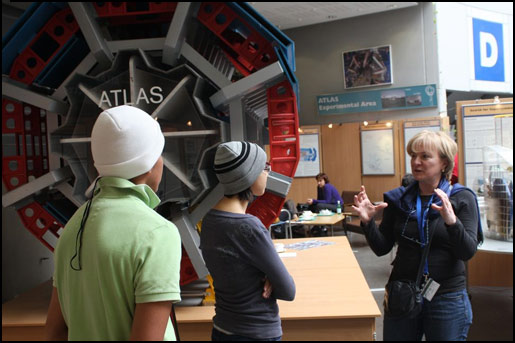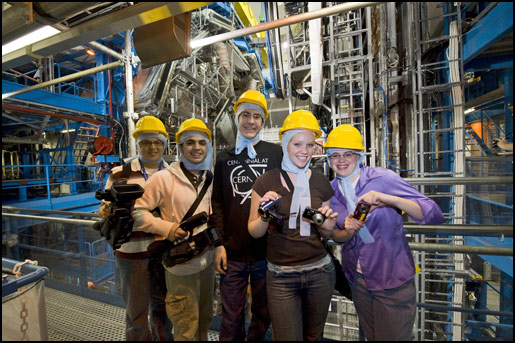
ATLAS e-News
23 February 2011
American student journalists witness the excitement of the Large Hadron Collider
14 April 2008

Alessandra Ciocio answering questions posed by some of the students
As journalists around the globe prepare for anticipated discoveries at the LHC, six teams of American high school students travelled to CERN as journalists April 2-7 and are now reporting back to their peers across the United States via blogs and videos. They arrived a few days before the CERN Open Day so had the chance to visit many sites and talk to many physicists both before and during the Open Day.
The 18 students witnessed the same excitement as the professional news media that have flocked to CERN in recent months, including the New York Times, National Geographic and the Discovery Channel. The six teams from five states across the U.S. were the winners of a competition sponsored and funded by the U.S. Department of Energy’s Office of Science and the National Science Foundation. Each team consisted of a teacher and three students who combined their expertise in physics, communications and video production.
Among the mysteries the students were asking physicists about were the origin of mass, the existence of extra dimensions of space and microscopic black holes, and the composition of dark matter. They had read the New York Times article about microscopic black holes and the lawsuit to stop the LHC. They asked many of their interviewees about whether there was any possibility of creating dangerous black holes (and were assured there was none). They also had a chance to see the only known Higgs to date: Peter Higgs was visiting CERN during Open Days.

The teams are continuing to report on their interviews with physicists and the public, tours of ATLAS, CMS and the LHC, as well as their cultural experiences. Professional news and video staff at CERN provided assistance and training for the students, who had access to video recording and editing equipment at CERN. Neal Hartman, an engineer with LBNL and an amateur filmmaker, and Katie Yurkewicz, the US-LHC communications officer, provided essential support.
We have been explaining to reporters and others that education is a major component of LHC physicists’ efforts. The excitement of the LHC and particle physics inspires young people to study and appreciate science. The students we motivate will eventually use their skills in many fields including science, education, industry, finance, and public policy.
The participants came from high schools in Tallahassee (Florida), Minneapolis (Minnesota), Rochester (New York), Houston (Texas), South Houston (Texas), and Payson (Utah).
For more information on the student journalist project, visit the project’s webpages at:
http://lhcscience.org/journalists. ATLAS eNews readers will soon have a chance to vote on the best picture and/or video produce by these students. So stay tuned!
